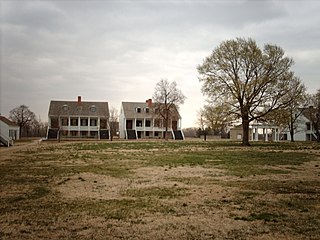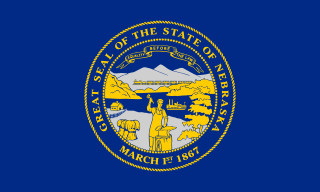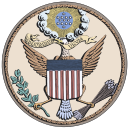
The Territory of Nebraska was an organized incorporated territory of the United States that existed from May 30, 1854, until March 1, 1867, when the final extent of the territory was admitted to the Union as the state of Nebraska. The Nebraska Territory was created by the Kansas–Nebraska Act of 1854. The territorial capital was Omaha. The territory encompassed areas of what is today Nebraska, Wyoming, South Dakota, North Dakota, Colorado, and Montana.

Fort Scott National Historic Site is a historical area under the control of the United States National Park Service in Bourbon County, Kansas, United States. Named after General Winfield Scott, who achieved renown during the Mexican–American War, during the middle of the 19th century the fort served as a military base for US Army action in what was the edge of settlement in 1850. For the next quarter century, it was used as a supply base and to provide security in turbulent areas during the opening of the West to settlement, a period which included Bleeding Kansas and the American Civil War.

Fort Kearny was a historic outpost of the United States Army founded in 1848 in the western U.S. during the middle and late 19th century. The fort was named after Col. and later General Stephen Watts Kearny. The outpost was located along the Oregon Trail near Kearney, Nebraska. The town of Kearney took its name from the fort. The "e" was added to Kearny by postmen who consistently misspelled the town name. A portion of the original site is preserved as Fort Kearny State Historical Park by the Nebraska Game and Parks Commission.

California's involvement in the American Civil War included sending gold east to support the war effort, recruiting volunteer combat units to replace regular U.S. Army units sent east, in the area west of the Rocky Mountains, maintaining and building numerous camps and fortifications, suppressing secessionist activity and securing the New Mexico Territory against the Confederacy. The State of California did not send its units east, but many citizens traveled east and joined the Union Army there, some of whom became famous.
The Indian Home Guard was a series of volunteer infantry regiments recruited from the Five Civilized Tribes of the Indian Territory to support the Union during the American Civil War. There was also a series of Confederate units of Indian Territory.

Fort Reno also known as Fort Connor or Old Fort Reno, was a wooden fort established on August 15, 1865 by the United States Army in Dakota Territory in present-day Johnson County, Wyoming. The fort was built to protect travelers on the Bozeman Trail from Native American tribes.

The Colorado Territory was formally created in 1861 shortly before the bombardment of Fort Sumter sparked the American Civil War. Although sentiments were somewhat divided in the early days of the war, Colorado was only marginally a pro-Union territory. Colorado was strategically important to both the Union and Confederacy because of the gold and silver mines there as both sides wanted to use the mineral wealth to help finance the war. The New Mexico Campaign was a military operation conducted by Confederate Brigadier General Henry Sibley to gain control of the Southwest, including the gold fields of Colorado, the mineral-rich territory of Nevada and the ports of California. The campaign was intended as a prelude to an invasion of the Colorado Territory and an attempt to cut the supply lines between California and the rest of the Union. However, the Confederates were defeated at the Battle of Glorieta Pass in New Mexico and were forced to retreat back to Texas, effectively ending the New Mexico Campaign.

The New Mexico Territory, comprising what are today the U.S. states of New Mexico and Arizona, as well as the southern portion of Nevada, played a small but significant role in the trans-Mississippi theater of the American Civil War. Despite its remoteness from the major battlefields of the east, and its being part of the sparsely populated and largely undeveloped American frontier, both Confederate and Union governments claimed ownership over the territory, and several important battles and military operations took place in the region. Roughly 7,000-8,000 troops from the New Mexico Territory served the Union, more than any other western state or territory.

The state of Iowa played a significant role during the American Civil War in providing food, supplies, troops and officers for the Union army.

The 1st Cherokee Mounted Rifles was a Confederate States Army regiment which fought in the Indian Territory during the American Civil War. It was formed from the merger of two predecessor units the First Regiment of Cherokee Mounted Rifles, and the Second Regiment of Cherokee Mounted Rifles. The first commander was Col. John Drew, while the second was Stand Watie.
Galvanized Yankees was a term from the American Civil War denoting former Confederate prisoners of war who swore allegiance to the United States and joined the Union Army. Approximately 5,600 former Confederate soldiers enlisted in the United States Volunteers, organized into six regiments of infantry between January 1864 and November 1866. Of those, more than 250 had begun their service as Union soldiers, were captured in battle, then enlisted in prison to join a regiment of the Confederate States Army. They surrendered to Union forces in December 1864 and were held by the United States as deserters, but were saved from prosecution by being enlisted in the 5th and 6th U.S. Volunteers. An additional 800 former Confederates served in volunteer regiments raised by the states, forming ten companies. Four of those companies saw combat in the Western Theater against the Confederate Army, two served on the western frontier, and one became an independent company of U.S. Volunteers, serving in Minnesota.

The 1st Nebraska Infantry Regiment was an infantry regiment that served in the Union Army during the American Civil War. It was initially organized to protect the Nebraska Territory from Indian attacks, but primarily served in the Western Theater before being reorganized and sent to the frontier.
The 1st Nebraska Cavalry Regiment was a cavalry regiment that served in the Union Army during the American Civil War.

During the American Civil War, most of what is now the U.S. state of Oklahoma was designated as the Indian Territory. It served as an unorganized region that had been set aside specifically for Native American tribes and was occupied mostly by tribes which had been removed from their ancestral lands in the Southeastern United States following the Indian Removal Act of 1830. As part of the Trans-Mississippi Theater, the Indian Territory was the scene of numerous skirmishes and seven officially recognized battles involving both Native American units allied with the Confederate States of America and Native Americans loyal to the United States government, as well as other Union and Confederate troops.
Alexander Early Steen was a career American soldier from Missouri who served in the United States Army in the Mexican–American War. He rejoined the army in 1852 and served until he resigned to join the Confederate forces on May 10, 1861. He served as a general in the secessionist Missouri State Guard forces and as a colonel and acting brigadier general in the Confederate States Army during the American Civil War. He was killed in the Battle of Prairie Grove.

The area that eventually became the U.S. state of Montana played little direct role in the American Civil War. The closest the Confederate States Army ever came to the area was New Mexico and eastern Kansas, each over a thousand miles away. There was not even an organized territory using "Montana" until the Montana Territory was created on May 26, 1864, three years after the Battle of Fort Sumter. In 1861, the area was divided between the Dakota Territory and the Washington Territory, and in 1863, it was part of the Idaho Territory.
The Department of Kansas was a Union Army command department in the Trans-Mississippi Theater during the American Civil War. This department existed in three different forms during the war.

John Milton Thayer was a general in the Union Army during the American Civil War and a postbellum United States Senator from Nebraska. Thayer served as Governor of Wyoming Territory and Governor of Nebraska.
On April 15, 1861, at the start of the American Civil War, U.S. President Abraham Lincoln called for a 75,000-man militia to serve for three months following the bombardment and surrender of Fort Sumter. Some southern states refused to send troops against the neighboring Deep South slave states of South Carolina, Mississippi, Florida, Alabama, Georgia, Louisiana, and Texas. The result was that most states in the Upper South of Virginia, Arkansas, North Carolina, and Tennessee also declared secession from the United States and joined the Confederate States.

The 8th Missouri Infantry Regiment was an infantry regiment of the Confederate States Army during the American Civil War. From May 1861, the war began affecting events in the state of Missouri. In 1862, Confederate recruiting activities took place in Missouri, and a cavalry regiment was formed in Oregon County, the nucleus being former members of the Missouri State Guard. On September 2, the unit entered Confederate service, but it was reclassified as infantry ten days later. After many of the men transferred to other units, the regiment was reclassified as a battalion on October 19 and named the 7th Missouri Infantry Battalion, also known as Mitchell's Missouri Infantry. It participated in a Confederate offensive at the Battle of Prairie Grove on December 7. During the battle, the unit made several charges against the Union lines but was repeatedly repulsed by artillery fire. The regiment spent most of early 1863 encamped near Little Rock and Pine Bluff in Arkansas.














